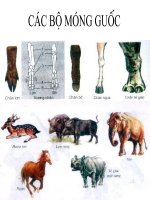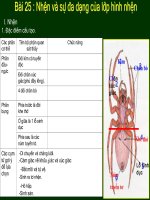Tải Giáo án tiếng Anh lớp 9 Tuần 22 sách mới - Giáo án điện tử môn tiếng Anh 9 theo tuần
Bạn đang xem bản rút gọn của tài liệu. Xem và tải ngay bản đầy đủ của tài liệu tại đây (148.29 KB, 8 trang )
<span class='text_page_counter'>(1)</span><div class='page_container' data-page=1>
<b>GIÁO ÁN TIẾNG ANH LỚP 9 </b>
<b> TUẦN 22</b>
<b>NĂM HỌC 2019 - 2020</b>
<b>Period: 7 Week: 22</b>
<b>Unit 7: RECIPES AND EATING HABITS</b>
<i><b>Lesson 6 – SKILLS 2</b></i>
<b>I. OBJECTIVES: By the end of this Unit, students will be able to:</b>
listen for detailed and specific information about teenagers’ eating habits write about the eating habits of a classmate
<b>II . PREPARATION: sub -board, pictures, cassette </b>
<b>III. PROCEDURES: </b>
<b>Teacher’s and students’ activities</b> <b>Content</b>
<b>Activity 1: </b>
- Have Ss do this activity in pairs. They ask each
other questions to find out the differences between
the two pictures. Elicit the answers from Ss. Ask
them to describe the underlying meaning of the
pictures.
<b>Activity 2:</b>
- Tell Ss that they are going to listen to two students
talking about their eating habits. Before listening, Ss
read through the statements to make sure they
understand them and to underline key words. Play
the recording for them to do the exercise. Call on
one student to write the answers on the board. Ask
other Ss if they agree with them. Play the recording
a second time for Ss to check. Don’t confirm the
correct answers now.
<b>Activity 3:</b>
- Without listening to the recording again, Ss
- Picture A: A boy is eating
chocolate. On the table there are
junk foods such as crisps, a
hamburger, soft drinks, and sweets.
The boy looks fat.
- Picture B: A girl is having rice. On
the table we can see soup, fish,
vegetables, and watermelon. The
girl looks slim and fit.
- Meaning: They show the contrast
between healthy eating and
unhealthy eating.
1. T 2. F
3. T 4. F
5. T 6. F
</div>
<span class='text_page_counter'>(2)</span><div class='page_container' data-page=2>
complete the table by filling each blank with no
more than three words. Have Ss compare their
answers with a classmate before giving the answers.
Ask two Ss to write their answers on the board. Play
the recording one last time to confirm the answers
<b>for both 2 and 3.</b>
<b>WRITING</b>
<b>-Activity 4:</b>
Ask Ss to work in pairs. They ask and answer
questions about each other’ s eating habits, and take
notes of their partner’s answers in the table.
After that give Ss a few minutes to read their notes
again to answer the questions provided.
T should move around to give comments as there
may not be enough time for checking with the whole
class.
<b>Activity 5:</b>
Ask Ss to write about their partner’s eating habits.
When they have finished, Ss exchange their writing
to spot any mistakes. Have Ss share the mistakes
with the whole class. T may collect some Ss’ work
to mark at home, or T may ask them to rewrite the
exercise as homework. In this case, remember to ask
for Ss’ revised work in the next lesson.
3. crisps 4. fried beef
5. vegetables 6. cereal
7. a banana 8. slices of bread
9. boiled egg 10. steamed fish
<i>Sample writing:</i>
</div>
<span class='text_page_counter'>(3)</span><div class='page_container' data-page=3>
her diet. First, if she wants to have
more energy for the day, she should
never skip breakfast. Second, she
must reduce the amount of fast food
she eats. Also, eating more
vegetables would be good for her.
She should also eat less rice for
dinner. These changes will
definitely keep her fit.
<b>IV- HOMEWORK:</b>
-Write new words then learn them by heart.
-Copy the exercise into notebooks.
<b>-Prepare LOOKING BACK</b>
<b>Period: 8 Week: 22</b>
<b>Unit 7: RECIPES AND EATING HABITS</b>
<i><b>Lesson 7 – LOOKING BACK</b></i>
<b>I. OBJECTIVES: By the end of this Unit, students will be able to:</b>
use some vocabularies and structures to talk about their favourite dishes and
recipes for dishes
<b>II . PREPARATION: sub -board, pictures, cassette </b>
<b>III. PROCEDURES: </b>
<b>Teacher’s and students’ activities</b> <b>Content</b>
<b>Activity 1: </b>
Have Ss do this exercise individually and then
compare their answers with a partner. Call on Ss to
read out loud their answers.
<b>Activity 2:</b>
- Ask Ss to complete the words individually. Check
</div>
<span class='text_page_counter'>(4)</span><div class='page_container' data-page=4>
Ss’ answers as a class. If time allows, call on one or
two Ss to write their answers on the board.
<b>Activity 3:</b>
- Ask Ss to do this exercise individually. Have some
Ss read out their answers. Confirm the correct ones.
<b>Activity 4:</b>
- Have Ss do this exercise individually. Check the
answers as a class. T may ask Ss to explain their
choice.
<b>Activity 5:</b>
- Ask Ss to write the sentences individually. Have
two Ss write the sentences on the board. Ask other
Ss to give comments. Correct the sentences if
needed.
<b>Activity 6:</b>
- Have Ss rearrange the lines to make a complete
conversation, first individually and then share their
answers with a partner. Ask some pairs to read out
E. roast F. grill
G. simmer H. stew
1. hamburger 2. sushi
3. deep-fry 4. steam
5. stew
1. slice 2. sticks
3. any - some 4. bag
5. clove 6. bunch
1. If you keep eating fast food, you
might become overweight.
2. If you promise to finish your
homework tonight, you can go to the
cinema with your friend.
3. He should eat less sweets if he
doesn’t want to have toothache.
4. She must eat less rice and bread if
she wants to lose weight.
5. If you join this cooking lesson,
you can cook many delicious dishes.
1. B 2. E
</div>
<span class='text_page_counter'>(5)</span><div class='page_container' data-page=5>
loud the conversation.
-Finished!
Ask Ss to complete the self-assessment. Identify any
difficulties and weak areas and provide further
practice if necessary.
<b>Project: A survey on eating habits</b>
1. Have Ss work in groups of four or five. They go
to other classes and ask different Ss about their
eating habits. To reduce the workload, each student
interviews three other Ss and records their answers
in the
table. This should be done early in the unit.
2. Group members meet together and organise the
answers in the form of an answer to each question.
The following table can serve as an example. This
summarises the answers of 12 Ss.
(Ss work in groups of 4).
Their findings might look like this:
– Question 1: Of 12 students answered, only three
usually eat fast food. Four of them sometimes eat
fast food, and five never have this kind of food.
– Question 2: …
3. Have groups present their findings to the class.
Finally, they conclude whether Ss at the school have
healthy eating habits.
<b>IV- HOMEWORK:</b>
-Write new words then learn them by heart.
-Copy the exercise into notebooks.
</div>
<span class='text_page_counter'>(6)</span><div class='page_container' data-page=6>
<b>Period: 9 Week: 22</b>
<b>Unit 8 : TOURISM</b>
<i><b>Lesson 1 - GETTING STARTED: Travel plans</b></i>
<b>I. OBJECTIVES: By the end of this Unit, students will be able to: use lexical items </b>
related to tourism
<b>II . PREPARATION: sub -board, pictures, cassette </b>
<b>III. PROCEDURES: </b>
<b>Teacher’s and students’ activities</b> <b>Content</b>
<b>Activity 1: </b>
Let sts open their book to GETTING STARTED
Tell them to look at the picture and answer the questions:
<b>-What are Nick and Chau talking about?</b>
-What place/ city may they be mentioning?
-What do you know about thus city country?
Tell sts they are going to listen to Nick and Chau talking about
Nick’s plans for his summer holiday.
Play the recording and have sts follow along.
a) Play the recording twice or more
Sts do the exercise individually.
Check and write the correct answers on the board.
T may call on an able st to write the answers on the
board.
Explain to sts the meaning and the use of the three expressions
<b>in the Watch out box. Ask sts to locate them in the </b>
conversation.
b) Sts work in pairs.
Tell them to refer back to the conversation when
necessary. Explain anything difficult.
T needs to explain to sts “ snails and frogs’ legs are
specialities in France.
1) Listen and read / p.18
Ex
a) Find a word / phrase in
the conversation that means:
1. made up your mind
2.narrowed it down
3. a package tour
4.explore
5.not my cup of tea
Ex
b)Tick ( ) true (T) or false
(F)
</div>
<span class='text_page_counter'>(7)</span><div class='page_container' data-page=7>
c) Sts work individually , then compare their answers with a
partner.
Help them find the information in the conversation.
Call on some pairs ro read out the questions and give
their answers.
Check their answers.
<b>Activity 2: </b>
This activity aims at giving the collocations of common words
related to the topic of travelling and tourism.
Sts work in pairs first. Check their work,then let them read and
remember each collocation.
<b>Activity 3: </b>
This exercise is a revision of words / phrases from previous
lessons.
Let sts work individually to do the task. Check their answers.
If time allows , call on some sts to read the passage with the
correct answers.
4.F
5.F
Ex
c) Answer the following
questions.
1.It means Nick’s parents are
relaxed and open-minded.
2. It’s quite warm ( warmer than
in Britain)
3.Visit the Alps , and climb
Mont Blanc, explore Paris , and
go sightseeing in the historic
city of Versailles.
4. Eat frogs’ legs and snails.
5.She says “ lucky you” when
Nick says he can make his own
decisions.
Ex2) Collocation: Wh i ch word
goes with which list below?
1.holiday
2.resort
3.tour
4.trip
Ex3) Fill each blank with a
word / phrase from the list.
1. seaside resort
</div>
<span class='text_page_counter'>(8)</span><div class='page_container' data-page=8>
<b>Activity 4: </b>
Sts do the exercise individually, then check their answers.
T may encourage each st to make a similar quiz for their partner
to do. T may pick up any interesting questions and give them to
the whole class. Praise good ideas.
Sts work in groups for 4, 5, 6. Check and give comments.
7.accommodation
8.price
Ex4) Quiz.
1. Da Nang City
2. The Great Wall of China
3. Jeju island
4. sts’ answers
5. sts’ answers
6. sts’ answers
<b>V- HOMEWORK:</b>
-Practice reading the dialogue.
-Write new words then learn them by heart.
-Copy the exercise into notebooks.
<b>-Prepare A CLOSER LOOK 1</b>
Mời bạn đọc tham khảo thêm tài liệu Tiếng Anh lớp 9 tại đây:
Bài tập Tiếng Anh lớp 9 theo từng Unit:
Bài tập Tiếng Anh lớp 9 nâng cao:
</div>
<!--links-->
Tài liệu Giáo án điện tử môn Xác suất thống kê - Tuần 2 doc
- 57
- 741
- 1








